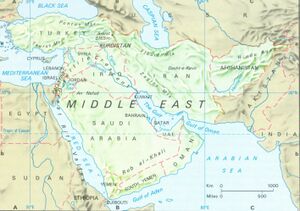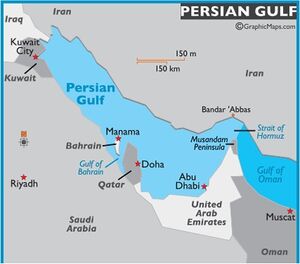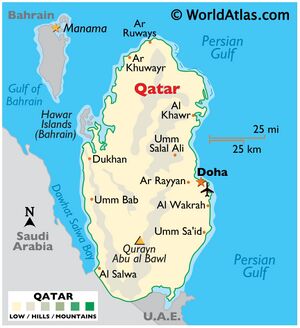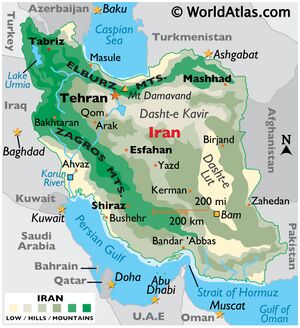Qatar
| Author:Laxman Burdak, IFS (R) |


Qatar (क़तर) is a country in Western Asia on the northeastern coast of the Arabian Peninsula in the Middle East, shares its sole land border with Saudi Arabia to the south. Its capital is Doha, home to over 80% of the country's inhabitants, and the land area is mostly made up of flat, low-lying desert.
Variants
Location
It occupies the Qatar Peninsula on the northeastern coast of the Arabian Peninsula in the Middle East; it shares its sole land border with Saudi Arabia to the south, with the rest of its territory surrounded by the Persian Gulf. The Gulf of Bahrain, an inlet of the Persian Gulf, separates Qatar from nearby Bahrain.
Etymology
Pliny the Elder, a Roman writer, documented the earliest account pertaining to the inhabitants of the peninsula around the mid-first century AD, referring to them as the Catharrei, a designation that may have derived from the name of a prominent local settlement.[1][2]
A century later, Ptolemy produced the first known map to depict the peninsula, referring to it as Catara.[3][4] The map also referenced a town named "Cadara" to the east of the peninsula.[5] The term "Catara" (inhabitants, Cataraei) was exclusively used until the 18th century, after which "Katara" emerged as the most commonly recognised spelling.[6] Eventually, after several variations — "Katr", "Kattar" and "Guttur" — the modern derivative Qatar was adopted as the country's name.[7]
In Standard Arabic, the name is pronounced [ˈqɑtˤɑr], while in the local dialect it is [ˈɡɪtˤɑr].[8]
English speakers use different approximate pronunciations of the name as the Arabic pronunciations use sounds not often used in English.[9]
Jat Gotras Namesake
- Katar = Qatar = Catharrei (Pliny.vi.32)
- Katara = Qatar = Catharrei (Pliny.vi.32)
- Kataria = Qatar = Catharrei (Pliny.vi.32)
- Katrah = Katr = Qatar = Catharrei (Pliny.vi.32)
- Kadaria = Cadara = Qatar = Catharrei (Pliny.vi.32)
Mention by Pliny
Pliny[10] mentions Arabia....We then (after the island of Tylos = Bahrain) come to the island of Asclie, and the nations of the Nocheti, the Zurazi, the Borgodi, the Catharrei, the Nomades, and then the river Cynos20.
20 Hardouin takes this to be that which by the Arabians is called by the name of Falg.
Salient features
Qatar has been ruled as a hereditary monarchy by the House of Thani since Mohammed bin Thani signed a treaty with the British in 1868 that recognised its separate status. Following Ottoman rule, Qatar became a British protectorate in 1916, and gained independence in 1971. The current emir is Tamim bin Hamad Al Thani, who holds nearly all executive and legislative authority under the Constitution of Qatar, as well as controlling the judiciary.[11] He appoints the prime minister and cabinet. The partially-elected Consultative Assembly can block legislation and has a limited ability to dismiss ministers.
In early 2017, the total population of Qatar was 2.6 million, with 313,000 of them Qatari citizens and 2.3 million expatriates.[12] Its official religion is Islam. In terms of income, the country has the fourth-highest GDP (PPP) per capita in the world,[13] and the eleventh-highest GNI per capita (Atlas method).[14] Qatar ranks 42nd in the Human Development Index, the third-highest HDI in the Arab world.[15] It is a high-income economy, backed by the world's third-largest natural gas reserves and oil reserves.[16] Qatar is one of the world's largest exporters of liquefied natural gas,[17] and the world's largest emitter of carbon dioxide per capita.[18]
In the 21st century, Qatar emerged as a middle power in the Arab world through its resource-wealth,[19]
Ancient History
Human habitation in Qatar dates back to 50,000 years ago. Settlements and tools dating back to the Stone Age have been unearthed in the peninsula.[20] Mesopotamian artifacts originating from the Ubaid period (c. 6500–3800 BC) have been discovered in abandoned coastal settlements.[21]
Al Da'asa, a settlement located on the western coast of Qatar, is the most important Ubaid site in the country and is believed to have accommodated a small seasonal encampment.[22][23]
Kassite Babylonian material dating back to the second millennium BC found in Al Khor Islands attests to trade relations between the inhabitants of Qatar and the Kassites in modern-day Bahrain.[24] Among the findings were 3,000,000 crushed snail shells and Kassite potsherds.[25]
It has been suggested that Qatar is the earliest known site of shellfish dye production, owing to a Kassite purple dye industry which existed on the coast.[26][27]
In 224 AD, the Sasanian Empire gained control over the territories surrounding the Persian Gulf.[28]
Qatar played a role in the commercial activity of the Sasanids, contributing at least two commodities: precious pearls and purple dye.
Under the Sasanid reign, many of the inhabitants in Eastern Arabia were introduced to Christianity following the eastward dispersal of the religion by Mesopotamian Christians.[29] Monasteries were constructed and further settlements were founded during this era.[30][31]
During the latter part of the Christian era, Qatar comprised a region known as Beth Qatraye (Syriac for "house of the Qataris").[32] The region was not limited to Qatar; it also included Bahrain, Tarout Island, Al-Khatt, and Al-Hasa.[33]
In 628, the Islamic prophet Muhammad sent a Muslim envoy to a ruler in Eastern Arabia named Munzir ibn Sawa Al Tamimi and requested that he and his subjects accept Islam. Munzir obliged his request, and accordingly, most of the Arab tribes in the region converted to Islam.[34] In the middle of the century, the Muslim conquest of Persia would result in the fall of the Sasanian Empire.[53]
Early and late Islamic period (661–1783)
Qatar was described as a famous horse and camel breeding centre during the Umayyad period.[35] In the 8th century, it started benefiting from its commercially strategic position in the Persian Gulf and went on to become a centre of pearl trading.[36][37]
Substantial development in the pearling industry around the Qatari Peninsula occurred during the Abbasid era.[38] Ships voyaging from Basra to India and China would make stops in Qatar's ports during this period. Chinese porcelain, West African coins, and artefacts from Thailand have been discovered in Qatar.[39] Archaeological remains from the 9th century suggest that Qatar's inhabitants used greater wealth to construct higher quality homes and public buildings. Over 100 stone-built houses, two mosques, and an Abbasid fort were constructed in Murwab during this period.[40][41] When the caliphate's prosperity declined in Iraq, so too did it in Qatar.[42] Qatar is mentioned in 13th-century Muslim scholar Yaqut al-Hamawi's book, Mu'jam Al-Buldan, which alludes to the Qataris' fine striped woven cloaks and their skills in improvement and finishing of spears.[43]
Much of Eastern Arabia was controlled by the Usfurids in 1253, but control of the region was seized by the prince of Ormus in 1320.[44] Qatar's pearls provided the kingdom with one of its main sources of income.[45]In 1515, Manuel I of Portugal vassalised the Kingdom of Ormus. Portugal went on to seize a significant portion of Eastern Arabia in 1521.[46][47] In 1550, the inhabitants of Al-Hasa voluntarily submitted to the rule of the Ottomans, preferring them to the Portuguese.[48] Having retained a negligible military presence in the area, the Ottomans were expelled by the Bani Khalid tribe and their emirate in 1670.[49]
क़तर का परिचय
क़तर (अरबी: قطر) अरब प्रायद्वीप के उत्तर पूर्वी तट पर स्थित इकलौता क्षेत्रीय प्रायद्वीपीय देश है। इसके दक्षिण में जहां सउदी अरब है, वहीं शेष तीनों ओर फ़ारस की खाड़ी है। एक तेल समृद्ध राष्ट्र के रूप में क़तर दुनिया का दूसरा (प्रति व्यक्ति सकल फरेलू उत्पाद) समृद्ध देश है। सन् १७८३ में कुवैत के अल खलीफ वंश ने यहां शासन करना प्रारम्भ किया। तत्पश्चात यह तुर्की के अधीन रहा। प्रथम विश्वयुद्ध के बाद यह ब्रिटेन के संरक्षण में रहा। १९७१ में स्वतंत्रता मिलने के बाद १९७२ में ख़लीफ़ा बिन हमद का शासन प्रारम्भ हुआ।
नामकरण: माना जाता है कि कतर नाम आज के जुबारा नामक शहर के प्राचीन नाम "कतारा" से उत्पन्न हुआ है, जो प्राचीन समय में क्षेत्र का महत्वपूर्ण बंदरगाह और शहर था। "कतारा" शब्द टोल्मी द्वारा बनाए गए अरब प्रायद्वीप के मानचित्र पर पहली बार नजर आया था।
कतर क्यों प्रसिद्ध है?: कतर की गिनती उन देशों में की जाती है जहां तेल और गैस का भंडार है। कतर में दुनिया का सबसे बड़ा गैस का भंडार है। इसी तेल और गैस के कारण कतर आज सफलता की सीढ़ी चढ़ता जा रहा है। यही तेल और गैस इस क्षेत्र में विवाद का कारण है।
कतर को हिंदी में क्या बोलते हैं? - पानी की बूंद, जलकण।
क़तर की राजधानी: दोहा (अरबी: الدوحة) अरब देशों में से एक, फ़ारस की खाड़ी में स्थित प्रायद्वीपीय देश क़तर की राजधानी और यहाँ का सबसे बड़ा नगर है।
कतर देश का इतिहास: मोहम्मद बिन थानी ने 1868 में अंग्रेजों के साथ एक संधि पर हस्ताक्षर करने के बाद से कतर पर थानी के घर पर शासन किया था, जिसने इसकी अलग स्थिति को मान्यता दी थी। तुर्क शासन के बाद, कतर 1971 में स्वतंत्रता प्राप्त करने तक 20 वीं शताब्दी में एक ब्रिटिश रक्षक बन गया। 2003 में, जनमत संग्रह में संविधान को भारी रूप से अनुमोदित किया गया, जिसके पक्ष में लगभग 98% थे। 21 वीं सदी में, कतर अपने विश्व स्तर पर विस्तार वाले मीडिया समूह, अल जज़ीरा मीडिया नेटवर्क के माध्यम से अरब दुनिया में एक महत्वपूर्ण शक्ति के रूप में उभरा
कतर देश का भूगोल: कतर प्रायद्वीप सऊदी अरब के उत्तर में फारस की खाड़ी में 160 किलोमीटर तक फैला है। देश के अधिकांश हिस्से में बालू से ढके एक कम, बंजर मैदान हैं। दक्षिण पूर्व में खोर अल अदैद ("अंतर्देशीय सागर") है, जो फारस की खाड़ी के एक इनलेट के चारों ओर रेत के टीलों का क्षेत्र है। हल्के सर्दियां होती हैं और बहुत गर्म, उमस भरी गर्मी होती है।
कतर देश की अर्थव्यवस्था: तेल की खोज से पहले, कतरी क्षेत्र की अर्थव्यवस्था मछली पकड़ने और मोती के शिकार पर केंद्रित थी। 1892 में ओटोमन साम्राज्य के स्थानीय गवर्नरों द्वारा तैयार एक रिपोर्ट में कहा गया है कि 1892 में मोती के शिकार से कुल आय 2,450,000 क्रान है। 1920 और 1930 के दशक में दुनिया के बाजार में जापानी सुसंस्कृत मोती की शुरुआत के बाद, कतर का मोती उद्योग दुर्घटनाग्रस्त हो गया। तेल 1940 में कतर में, दुखन फील्ड में खोजा गया था। इस खोज ने राज्य की अर्थव्यवस्था को बदल दिया। अब, देश में अपने कानूनी नागरिकों के लिए उच्च जीवन स्तर है। इनकम टैक्स नहीं होने से कतर (बहरीन के साथ) दुनिया के सबसे कम टैक्स रेट वाले देशों में से एक है। जून 2013 में बेरोजगारी की दर 0.1% थी। कॉर्पोरेट कानून कहता है कि कतरी नागरिकों को अमीरात में किसी भी उद्यम का 51% हिस्सा होना चाहिए। अमीरात में व्यापार और उद्योग की देखरेख व्यापार और व्यापार मंत्रालय द्वारा की जाती है।
कतर देश से जुड़े रोचक तथ्य और अनोखी जानकारियाँ:
- कतर को आधिकारिक और पर कतर राज्य कहा जाता है जो अरब प्रायद्वीप के उत्तर पूर्वी तट पर स्थित प्रायद्वीप है।
- कतर की सीमाएं दक्षिण में सउदी अरब से लगती है शेष भाग फारस की खाड़ी से घिरा हुआ है।
- कतर ने 3 सितंबर 1971 को युनाईटेड किंगडम (UK) से स्वतंत्रता हासिल की थी।
- कतर का कुल क्षेत्रफल 11,581 वर्ग कि.मी. (4,471 वर्ग मील) है।
- कतर की आधिकारिक भाषा अरबी है।
- कतर की मुद्रा का नाम रियाल है।
- विश्व बैंक के अनुसार 2016 में कतर की कुल जनसंख्या 25.7 लाख थी।
- कतर में अधिकत्तर लोगो का धर्म इस्लाम हैं।
- कतर में सबसे महत्वपूर्ण जातीयसमूह गैर कतरी और कतरी है।
- कतर की जलवायु रेगिस्तानी है जिसमे बहुत हल्की सर्दियाँ है, और बहुत गर्म और धूप वाली गर्मी है।
- कतर का सबसे ऊँच बिंदु कुरान अबू अल बाउल (Qurayn Abu al Bawl) है, जिसकी ऊंचाई 103 मीटर है।
- कतर में महिलाओं को गाडी चलाने की आज़ादी है, लेकिन उनकी स्वतंत्रता के हालात बाकी अरब देशो की ही तरह खराब है।
- कतर में साल 2014 में खोला गया हमद अंतरराष्ट्रीय हवाई अड्डा हर साल लगभग 50 लाख यात्रियों को संभालता है।
External links
References
- ↑ Casey, Paula; Vine, Peter (1992). The heritage of Qatar. Immel Publishing. p. 17. ISBN 9780907151500.
- ↑ "History of Qatar". Qatar Statistics Authority.
- ↑ "History of Qatar". Qatar Statistics Authority.
- ↑ "Maps". Qatar National Library.
- ↑ "About us". Katara.
- ↑ "Maps". Qatar National Library.
- ↑ Habibur Rahman (2010). The Emergence of Qatar: The Turbulent Years 1627–1916. London: Routledge. p. 1. ISBN 9780710312136.
- ↑ Johnstone, T. M. (2008). "Encyclopaedia of Islam". Ķaṭar. Brill Online.
- ↑ Lyall, Sarah (21 November 2022). "The 2022 World Cup is being hosted in Qatar, which, as everyone knows, is pronounced..." The New York Times.
- ↑ Natural History by Pliny Book VI/Chapter 32
- ↑ "Qatar: Freedom in the World 2020 Country Report". Freedom House.
- ↑ "Population of Qatar by nationality – 2017 report".
- ↑ "GDP per capita, PPP (current international $) | Data". data.worldbank.org.
- ↑ "GNI per capita, Atlas method (current US$) | Data". data.worldbank.org.
- ↑ Nations, United (8 September 2022). "Human Development Report 2021-22".
- ↑ "Indices & Data | Human Development Reports". United Nations Development Programme. 14 March 2013.
- ↑ "2022 World LNG Report Press Release" (PDF). International Gas Union (IGU). 6 July 2022.
- ↑ "Where in the world do people emit the most CO2?". Our World in Data
- ↑ Cooper, Andrew F. "Middle Powers: Squeezed out or Adaptive?". Public Diplomacy Magazine. Archived from the original on 17 March 2015.
- ↑ Toth, Anthony. "Qatar: Historical Background." A Country Study: Qatar (Helen Chapin Metz, editor). Library of Congress Federal Research Division (January 1993). This article incorporates text from this source, which is in the public domain.
- ↑ Khalifa, Haya; Rice, Michael (1986). Bahrain Through the Ages: The Archaeology. Routledge. pp. 79, 215. ISBN 978-0710301123.
- ↑ "History of Qatar" (PDF). www.qatarembassy.or.th. Ministry of Foreign Affairs. Qatar. London: Stacey International, 2000.
- ↑ Rice, Michael (1994). Archaeology of the Persian Gulf. Routledge. pp. 206, 232–233. ISBN 978-0415032681.
- ↑ Magee, Peter (2014). The Archaeology of Prehistoric Arabia. Cambridge Press. pp. 50, 178. ISBN 9780521862318.
- ↑ "History of Qatar" (PDF). www.qatarembassy.or.th. Ministry of Foreign Affairs. Qatar. London: Stacey International, 2000.
- ↑ Khalifa, Haya; Rice, Michael (1986). Bahrain Through the Ages: The Archaeology. Routledge. pp. 79, 215. ISBN 978-0710301123.
- ↑ Sterman, Baruch (2012). Rarest Blue: The Remarkable Story Of An Ancient Color Lost To History And Rediscovered. Lyons Press. pp. 21–22. ISBN 978-0762782222.
- ↑ Cadène, Philippe (2013). Atlas of the Gulf States. BRILL. p. 10. ISBN 978-9004245600.
- ↑ Gillman, Ian; Klimkeit, Hans-Joachim (1999). Christians in Asia Before 1500. University of Michigan Press. pp. 87, 121. ISBN 978-0472110407.
- ↑ Commins, David (2012). The Gulf States: A Modern History. I. B. Tauris. p. 16. ISBN 978-1848852785.
- ↑ Habibur Rahman, p. 33
- ↑ "AUB academics awarded $850,000 grant for project on the Syriac writers of Qatar in the 7th century AD" (PDF). American University of Beirut. 31 May 2011. Archived from the original (PDF) on 28 May 2015
- ↑ Kozah, Mario; Abu-Husayn, Abdulrahim; Al-Murikhi, Saif Shaheen (2014). The Syriac Writers of Qatar in the Seventh Century. Gorgias Press LLC. p. 24. ISBN 978-1463203559.
- ↑ "Bahrain". maritimeheritage.org.
- ↑ Rahman, Habibur (2006). The Emergence Of Qatar. Routledge. p. 34. ISBN 978-0710312136.
- ↑ A political chronology of the Middle East. Routledge / Europa Publications. 2001. p. 192. ISBN 978-1857431155.
- ↑ Page, Kogan (2004). Middle East Review 2003–04: The Economic and Business Report. Kogan Page Ltd. p. 169. ISBN 978-0749440664.
- ↑ Rahman, Habibur (2006). The Emergence Of Qatar. Routledge. p. 34. ISBN 978-0710312136.
- ↑ Fromherz, Allen (13 April 2012). Qatar: A Modern History. Georgetown University Press. pp. 44, 60, 98. ISBN 978-1-58901-910-2.
- ↑ Qatar, 2012 (The Report: Qatar). Oxford Business Group. 2012. p. 233. ISBN 978-1907065682.
- ↑ Casey, Paula; Vine, Peter (1992). The heritage of Qatar. Immel Publishing. pp. 184–185. ISBN 9780907151500.
- ↑ Russell, Malcolm (2014). The Middle East and South Asia 2014. Rowman & Littlefield Publishers. p. 151. ISBN 978-1475812350.
- ↑ History". qatarembassy.net. Archived from the original on 17 February 2015.
- ↑ Larsen, Curtis (1984). Life and Land Use on the Bahrain Islands: The Geoarchaeology of an Ancient Society (Prehistoric Archeology and Ecology series). University of Chicago Press. p. 54. ISBN 978-0226469065.
- ↑ Althani, Mohamed (2013). Jassim the Leader: Founder of Qatar. Profile Books. p. 16. ISBN 978-1781250709.
- ↑ Althani, Mohamed (2013). Jassim the Leader: Founder of Qatar. Profile Books. p. 16. ISBN 978-1781250709.
- ↑ Gillespie, Carol Ann (2002). Bahrain (Modern World Nations). Chelsea House Publications. p. 31. ISBN 978-0791067796.
- ↑ Anscombe, Frederick (1997). The Ottoman Gulf: The Creation of Kuwait, Saudi Arabia, and Qatar. Columbia University Press. p. 12. ISBN 978-0231108393.
- ↑ Potter, Lawrence (2010). The Persian Gulf in History. Palgrave Macmillan. p. 262. ISBN 978-0230612822.
Back to Jat Places in Foreign

